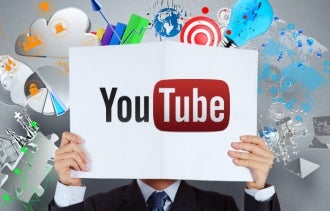
Content marketing is part art with a touch of science.
Creating great content requires a word smith or a creative video producer. The better this foundation is, the more attractive the content is to the viewer and increasing its chances for sharing on the web.
That’s the art part.
So we all know that high quality content and social media sharing and engagement are the driving force behind traffic and conversions. Yet most people don’t have a clear strategy for tracking and analysing performance.
This is the simple science.
Most of us periodically check our Google Analytics to find the number of visitors, or referrals from Google or Facebook, but few know how to use other data available in analytics to maximize their social media and content marketing strategies.
Do you know how to use Google Analytics data to come up with ideas for new articles? Or how Pinterest analytics can help you learn more about your buyer personas, thus helping you shape your message?
In this article I will discuss 6 simple ways to use analytics data to assist with your content marketing strategy.
1. Using long-tail keywords for keyword research
Keyword research is an easy way to brainstorm content. While you might optimize your site architecture with your primary keywords, you also probably know that these should be used sparingly in order to avoid picking up red flags by Penguin.
However, the long-tail keywords you find during your keyword research can still be incorporated into your content. Keyword buckets and competitive research should yield hundreds of potential keywords that can be used as inspiration for content.
If the content is going onto your site, use keywords as the base for article titles and organize them to create a flow for an editorial calendar. High-value keywords can be interspersed with diverse and low-competition keywords, all of which will benefit your site, while allowing you generate large amounts of content and keep to a regular posting schedule.
Start by going to Google Analytics, and pulling a Search report by keyword (Traffic Sources > Sources > Search > Overview). Change the number of keywords displayed to 100. Then take those keywords and use them to run a ranking report. Identify keywords that have brought you traffic but you are not ranking in the top 5. Then use those keywords as part of your content marketing efforts.
2. Creating personas
When publishing content you should always have a target audience in mind, but within that audience you can develop buyer personas that will help you understand who you are writing for and what their interests will be. You want to consider which stage of the purchase funnel they belong to as well as what questions they may want answered.
As you move along your publishing schedule, you will begin to see which personas respond to your content. Perhaps those in your top-of-the-funnel persona comment most on general advice articles, while those toward the bottom of the funnel are more likely to share your latest company updates on social media. You want to be aware of what they are responding to and react accordingly.
You can track social shares with a tool like TrackUr, or of course, Google Analytics.
3. Studying pinterest
When it comes to content marketing, Pinterest is a valuable social media platform. Pinterest is based solely on unique, shareable content, which makes it the perfect pool for brainstorming and testing out ideas.
Determine what category your content falls under and at a quick glance you can see what types of content are trending and getting the most repins. Look at sites like Repinly which tracks the most popular pins and boards on Pinterest to get ideas of what content will perform well on Pinterest, and what you should be pinning to gain your own Pinterest following.
Once you’ve begun pinning you can delve into analytics data with tools like PinLeague, which I use to look at the statistics of images that Iíve pinned as well as what images have been pinned from my website. You can see what images and pins are getting shared and by whom, which can give you insight into your audience demographics and help further develop your buyer personas.
4. Benchmarking real-time data
Benchmarking is also extremely important to keeping on top of your content marketing efforts. These tools can help you grasp the popularity of your content and what direction it should take by providing a range of metrics.
Cyfe is the benchmarking dashboard Iíve found most useful as it allows me to track a variety of metrics on multiple social platforms, and displays that information all in one place for quick, real-time analysis of social followers, visitors, leads and customers.
Comparing this data to a site-specific tool like Pinleague will allow you to better understand what content your audience is responding to, and the better you understand your audience, the sooner you will be able to produce content that is valuable and relevant to that audience.
Cyfe is a tool that i refer to on a daily basis. It allows me to, at a glance, see how all of my sites and clients are performing. I can see traffic trends, social shares, and much more. From this view, I can then investigate if I see a major spike or decrease of traffic. For example, if there ís a spike in traffic and social shares, I will then go to Google Analytics and find the landing page that generated this traffic and social shares. Then, based on the content, I wíll write more content specific to this topic.
5. Sharing site-specific content
Now that you have an understand of exactly what content your audience wants, you can begin to create strategies specific to each site you intend to share it on.
Pinleague will give you an idea of what content is most shareable on Pinterest. If, for example, a company that sells study guides posts an infographic on the college acceptance rates, and gets 10 unique pins and 500 repins, then any future content they develop on college statistics should be accompanied by strong graphics so that it can be easily integrated into Pinterest.
At the same time, fans of their Facebook page might prefer study guide updates or the latest discounts, which reveals that Facebook might be the best site for attracting traffic and conversions. By paying attention to analytics data you can convert them from followers to potential clients to sales.
6. Repurpose content
Now that you are tracking and investigating the success of your content, you have access to a wealth of data about the performance of your content. Let’s say that one of your infographics gets tons of repins. Why not convert this infographic into a video? Or write an article based on the content for the infographic, or vice versa?
Repurposing content, especially content that you already know is successful and your audience really likes, is an excellent way to increase your reach without taking much of a gamble. Youíd be maximizing your resources to create more opportunities for conversions.
How to get started
So I have given you the theory, now let’s get to practicalities:
- Set a weekly task for yourself to visit your Google Analytics account and check the performance of your content based on Landing Pages and Keywords. Check out bounce rate, engagement, conversion rate, etc for these so you can determine how your content is performing.
- Set up a ranking tool. If you donít already have keyword tracking in place, go to AuthorityLabs and create an account. Enter your most popular keywords, as well as keywords that are bringing you the most traffic from Google. Plan on creating more content around keywords that are bringing in traffic but not ranking in the top 5.
- Set up social media analytics software†to track your social shares and in-depth statistics for Facebook, Twitter, Google Plus and Pinterest. Cyfe is also a great dashboard to set up as an overview.
- Use the data from all the sources mentioned above to modify your editorial calendar and content marketing strategy.
How do you use Analytics for content marketing? What has helped you maximize the efforts of your content marketing strategy? Don’t be shy….share!


















